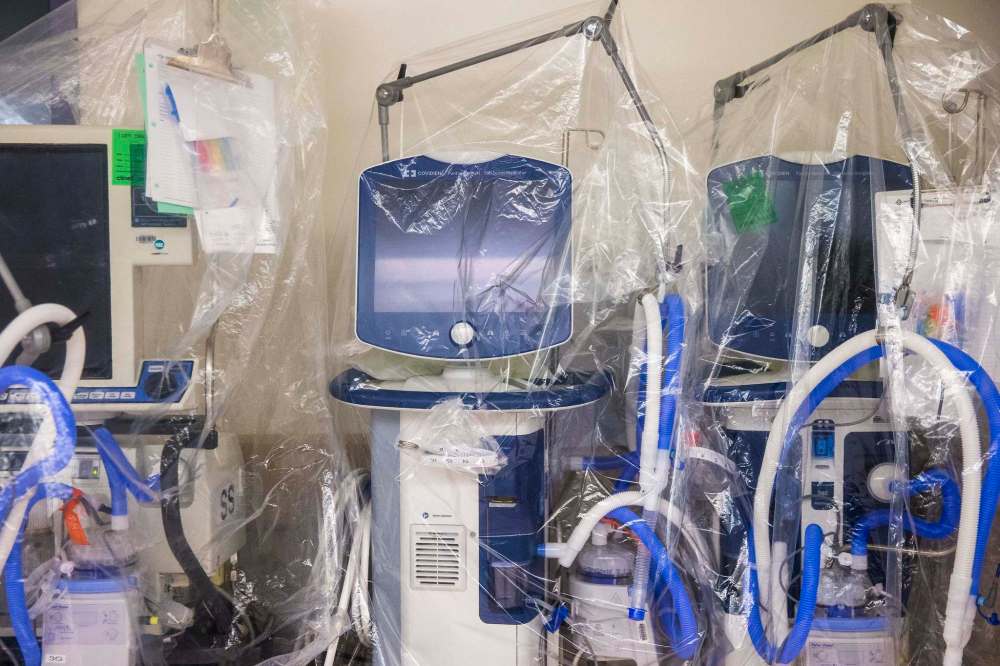Extender nurses stretched to limits Pandemic weight heavy on health-care professionals redeployed to Manitoba ICUs
Read this article for free:
or
Already have an account? Log in here »
To continue reading, please subscribe:
Monthly Digital Subscription
$0 for the first 4 weeks*
- Enjoy unlimited reading on winnipegfreepress.com
- Read the E-Edition, our digital replica newspaper
- Access News Break, our award-winning app
- Play interactive puzzles
*No charge for 4 weeks then price increases to the regular rate of $19.00 plus GST every four weeks. Offer available to new and qualified returning subscribers only. Cancel any time.
Monthly Digital Subscription
$4.75/week*
- Enjoy unlimited reading on winnipegfreepress.com
- Read the E-Edition, our digital replica newspaper
- Access News Break, our award-winning app
- Play interactive puzzles
*Billed as $19 plus GST every four weeks. Cancel any time.
To continue reading, please subscribe:
Add Free Press access to your Brandon Sun subscription for only an additional
$1 for the first 4 weeks*
*Your next subscription payment will increase by $1.00 and you will be charged $16.99 plus GST for four weeks. After four weeks, your payment will increase to $23.99 plus GST every four weeks.
Read unlimited articles for free today:
or
Already have an account? Log in here »
Hey there, time traveller!
This article was published 01/02/2021 (1779 days ago), so information in it may no longer be current.
The drugs were one of the first things Kathleen had to learn. In all her years of nursing, she’d never dealt with some of them before.
Drugs to keep blood pressure up. Drugs to support struggling hearts. Seven or more different drugs dripping into veins at once, a thin medicated line keeping desperately ill patients alive.
There were patients on dialysis. Tiny catheters threaded into arteries to measure blood pressure or devices which tracked the pressure inside a heart. Each of these pumped out data Kathleen had never before had to monitor.
Getting it right could be a matter of life and death.

For Kathleen — like the other nurses quoted in this story, the Free Press isn’t using her real name — it has been a struggle. Ever since she was redeployed last fall, one of the so-called “extender” nurses assigned to Manitoba ICUs as hospital beds filled up amidst the COVID-19 pandemic, the experienced nurse has been gripped by constant anxiety.
Some shifts, it gets to be too much. Every time Kathleen went to work in December, she cried.
“It’s definitely the fear of missing something or making a mistake and not knowing what to do,” she said, speaking over the phone in mid-January. “I’m uncomfortable with the assignments I’m given the majority of the time. There’s usually some kind of medication that I’m not familiar with, or some kind of device that I’m not trained on.
“It’s slowly getting better, but just because we’ve been forced to. My mental health has taken a big nose dive.”
“I’m uncomfortable with the assignments I’m given the majority of the time. There’s usually some kind of medication that I’m not familiar with, or some kind of device that I’m not trained on.” – Kathleen
She’s not alone. Over the most critical phase of the pandemic, the burden of saving lives fell heaviest on ICU nurses, including those redeployed from other wards.
Some had past critical care experience; Kathleen and other extenders had none, which made for a steep learning curve.
To Kathleen, it often felt as if she was left to fend for herself. It wasn’t for lack of support from the regular unit staff; it’s just they had too many demands on their time to take her fully under their wing. That made worse the uncertainty of navigating medications and devices with which she had little experience.

“The majority of the time, they (ICU nurses) are really nice about it, and they understand and they’re helpful, and they do what they can, but it leaves me feeling lost a lot of the time,” Kathleen said. “At the end of the day, it’s my name on the patient. And it’s my licence on the line.”
There is a light at the end of the tunnel. After months of code red restrictions, Manitoba’s hospitalization numbers appear stable, and falling.
Still, pressure on ICUs remains high: as of Monday, 102 patients were in critical care, including 38 with COVID-19-related illness. Before the pandemic, the province had 72 total ICU beds.
Speaking at a news conference Monday, Shared Health chief nursing officer Lanette Siragusa acknowledged how anxious many health-care staff are to roll back redeployments.
“I know everybody wants to go back to normal as soon as possible,” she said. “But it is going to be a slow, steady, cautious change.”

Getting out of this situation may be slow, but getting in wasn’t.
Normally, nurses looking to work in critical care take a months-long program which combines theory and hands-on experience. But in the pandemic surge, redeployed nurses and extenders say they received only one day of orientation before being assigned to care for patients.
One redeployed nurse, Isabelle, who had past critical care experience, understands the bind hospitals were in: “They needed to do something.”
It was anxious for her, too, to return to the ICU and relearn its specialized skills. She thought about how much harder it would be to make the leap without that background.
“The extenders I’ve talked to, it’s mostly been negative experiences,” Isabelle said. “They’re not happy. They’re anxious. They’re nervous they’re going to be placed in a situation where they’re not comfortable.”
“The majority of the time, they (ICU nurses) are really nice about it, and they understand and they’re helpful, and they do what they can, but it leaves me feeling lost a lot of the time. At the end of the day, it’s my name on the patient. And it’s my licence on the line.” – Kathleen
Originally, extender nurses were intended to support regular ICU staff. They’re used slightly differently at each facility: in Winnipeg, at Health Sciences Centre, new staff are organized into teams with veteran nurses; at St. Boniface, several told the Free Press, extenders have been assigned their own patients, usually one or two relatively stable ones.
Stable, in this case, is relative. “There’s still a reason they’re in ICU,” one nurse said.
In both models, nurses say, it was hard for less-experienced staff to find adequate support as beds filled up. At one point, Manitoba’s ICUs were filled to nearly 150 per cent of pre-pandemic capacity, while the typical one-to-one model of care in the unit was stretched as far as, in some cases, one nurse handling three patients.
“Most of the time, I would kind of be on my own,” said Sarah, who began working at an ICU in late 2020. “They couldn’t really monitor everything I was doing… It’s not for lack of people trying to support me. It’s just been this overwhelming surge of acuity like we haven’t seen before, and also this reduction in staff.”
It was not what Sarah imagined, when she signed up to become an ICU nurse. She’d long been interested in the work, attracted by what she calls the “standard of excellence.”

“You heard all about how it was the creme de la creme, in terms of the best nursing you can give,” she said.
So in the spring of 2020, as Manitobans hunkered down at home to brace against the first wave of COVID-19, she signed up to train for critical care. By December, she was working on the ward and managing her own patients, part of the crucial front line working round the clock.
In those weeks, it felt like every patient had COVID-19. They were incredibly sick — experienced nurses often remarked at how they were the sickest patients they’d seen in years — and while Sarah did feel the unit worked as a team, it felt to her like a team operating shorthanded.
“COVID was spoken of as a war. It was, ‘We’re fighting COVID, and the front-line people, they’re our soldiers.’ But I didn’t know we were going to staff this army with like, three people,” Sarah said, dryly. “I’ve never seen that level of excellence we’re talking about. I’ve only seen people in war, and in suffering.”
That suffering was felt in many ways. Death is no stranger to an ICU, but during the peak of Manitoba’s tragic second wave, nurses saw as many as four patients die in one shift. Each emptied bed was filled swiftly by what Sarah called a “conveyor belt” of incoming COVID-19 cases, a new set of lives hanging by a thread.
“The extenders I’ve talked to, it’s mostly been negative experiences. They’re not happy. They’re anxious. They’re nervous they’re going to be placed in a situation where they’re not comfortable.” – Isabelle
Those deaths were made even harder by the fact, in most cases, families were not allowed in the building.
“It’s more difficult for the staff, because they’re cut off from (the patients’) families right now,” Isabelle said. “You’re doing Zoom calls. If a patient can sit up and is awake, or even seem to interact with eye movements on an iPad, that’s great. But a lot of these people can’t. Their families only come in at their final moments.
“As their caregiver, it also adds to the grief. It’s difficult for the families, but it’s difficult for the staff, too.”
The effect of these last few months, some nurses say, is staff morale has been knocked down to the lowest level seen in years. Sarah said she’s seen “a lot of despair and, honestly, trauma” among her colleagues; Kathleen said all the nurses she knows have been talking about taking stress leave, going part-time or even quitting.
“Everyone’s just having panic attacks, anxiety attacks, and not sleeping.”
It raises the question of what nurses think should have been done differently.

Clear communication would have helped, Kathleen said: she was initially told she would not manage ICU patients herself, but rather support the unit’s nurses. If she’d known what to expect, she would have been more prepared.
“I think a lot of these decisions were made in haste, because numbers were climbing daily and needs were climbing daily,” Isabelle said. “But the way it was done, probably they could have done it a little bit different. They could have put more emphasis on staff engagement… You’re upending somebody and putting them in different units.
“Orientation would have been beneficial… or even just have somebody from management reach out and say to you, as an individual, ‘Hey, how do you feel in your comfort level? Are there any skills refreshers you need? Is there any orientation you need? How can we support you?'”
For now, Kathleen dreams of the day she’ll get to go back to her regular position, where she feels comfortable and in full command of the skills she needs to care for patients.
“Right now, I’m just bitter and I’m angry and I regret going into nursing,” she said. “We’re just numbers and we’re put wherever they need us to fill the gaps, but it doesn’t actually matter if it’s appropriate or not.
“It’s left a bad taste in my mouth, the whole way we’ve been treated.”
melissa.martin@freepress.mb.ca
Our newsroom depends on a growing audience of readers to power our journalism. If you are not a paid reader, please consider becoming a subscriber.
Our newsroom depends on its audience of readers to power our journalism. Thank you for your support.










